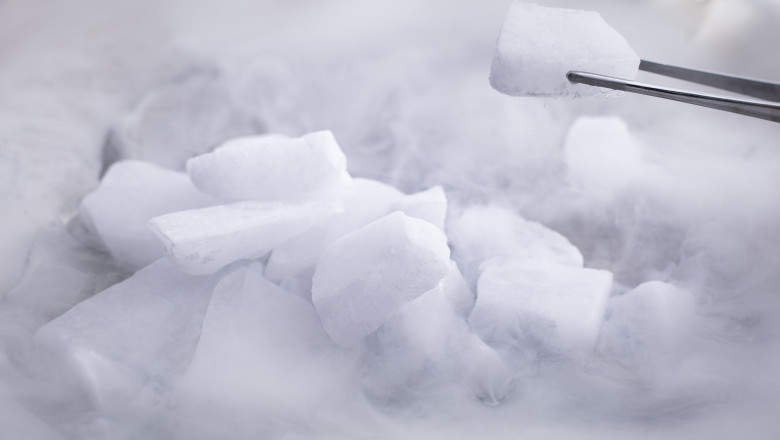views
What is Dry Ice?
Dry ice is the solid form of carbon dioxide (CO2) that exists at an extremely cold temperature of -78.5°C (-109.3°F). Unlike regular ice, which is frozen water, dry ice undergoes sublimation – a process where it transforms directly from a solid to a gas without passing through the liquid phase. This unique characteristic makes it invaluable for various industrial, commercial, and recreational applications. When dry ice sublimates, it creates a fascinating fog-like effect as the cold CO2 gas interacts with moisture in the air, making it popular for special effects in entertainment.
Manufacturing Process
The production of Dry Ice begins with liquid CO2, which is compressed and cooled until it transforms into a snow-like consistency. This CO2 snow is then compressed into blocks or pellets under high pressure. The compression process removes any air pockets, creating a dense, solid material. Modern manufacturing facilities use specialized equipment to ensure consistent quality and various size options, from large blocks to tiny pellets, catering to different applications. The manufacturing process is continuous, allowing for steady supply to meet industrial and commercial demands.
Industrial and Commercial Applications
Dry ice finds extensive use across multiple industries. In food preservation, it's crucial for maintaining the cold chain during transportation of perishable items. The medical field relies on it for shipping biological samples and vaccines at precise temperatures. Industries use it for cleaning purposes through dry ice blasting, where pellets are accelerated at high speeds to clean surfaces without leaving residue or causing water damage. Shipping companies utilize it for temperature-sensitive deliveries, while the hospitality industry uses it for food storage and creating dramatic effects in cocktails and food presentation.
Storage and Handling Requirements
Proper storage of dry ice requires specialized containers that allow for gas ventilation while maintaining insulation. Standard coolers or insulated containers work well, but they must never be completely airtight as the building pressure from sublimation can be dangerous. The storage area should be well-ventilated and away from living spaces. When handling dry ice, proper protective equipment including insulated gloves is essential, as direct contact with skin can cause severe frostbite. The storage duration depends on various factors, including container quality and ambient temperature, but typically ranges from 1-5 days.
Safety Considerations
Safety is paramount when working with dry ice. The extreme cold temperature poses immediate risks of frostbite and cold burns upon direct contact. Additionally, as dry ice converts to CO2 gas, it can displace oxygen in poorly ventilated areas, creating potential suffocation hazards. Users must ensure proper ventilation in storage and working areas. Transportation of dry ice must comply with specific regulations, particularly for air travel, where it's considered a dangerous good. Clear labeling and proper packaging are essential for safe handling and transport.
Environmental Impact and Sustainability
While dry ice itself doesn't contribute to additional carbon emissions since it's made from recaptured CO2, the manufacturing process does require energy. Modern production facilities are increasingly adopting energy-efficient methods and sustainable practices. The transportation and storage of dry ice also have environmental implications, primarily related to energy consumption for maintaining cold temperatures. However, compared to mechanical refrigeration, dry ice can be more energy-efficient for certain short-term applications.
Domestic and Entertainment Uses
Beyond industrial applications, dry ice has found its way into domestic and entertainment settings. It's popular for creating spooky Halloween effects, preserving food during power outages, and adding dramatic flair to parties and events. In home settings, it can be used for flash-freezing foods, making homemade ice cream, and removing floor tiles. However, users must strictly follow safety guidelines, as improper handling in domestic settings can be particularly dangerous due to limited ventilation and lack of professional expertise.
Cost Considerations and Availability
The cost of dry ice varies depending on quantity, location, and supplier. Prices typically range from $1-3 per pound for retail purchases, with bulk orders receiving significant discounts. Availability has improved with increasing distribution networks, making it accessible through grocery stores, ice suppliers, and specialty retailers. However, because it sublimates relatively quickly, purchasing should be timed close to intended use. Some suppliers offer delivery services, particularly for commercial quantities.
Scientific and Research Applications
The scientific community utilizes dry ice extensively in laboratory settings. It's crucial for maintaining low temperatures in experiments, preserving specimens, and creating controlled cold environments. In research facilities, it's used for freeze-trapping compounds, cooling reaction vessels, and maintaining ultra-low temperatures for sensitive materials. The predictable sublimation rate makes it valuable for calibrating instruments and conducting specific experiments requiring precise temperature control.
Get More Insights On- Dry Ice
Get this Report in Japanese Language:
Get this Report in Korean Language:
About Author:
Vaagisha brings over three years of expertise as a content editor in the market research domain. Originally a creative writer, she discovered her passion for editing, combining her flair for writing with a meticulous eye for detail. Her ability to craft and refine compelling content makes her an invaluable asset in delivering polished and engaging write-ups.
(LinkedIn: https://www.linkedin.com/in/vaagisha-singh-8080b91)















![What Is The QuickBooks Enterprise Support Number [[GET Quick Assistance]]](https://timessquarereporter.com/public/upload/media/posts/2025-06/04/what-is-the-quickbooks-enterprise-support-number-get-quick-assistance_1749095947-s.jpg)






Comments
0 comment